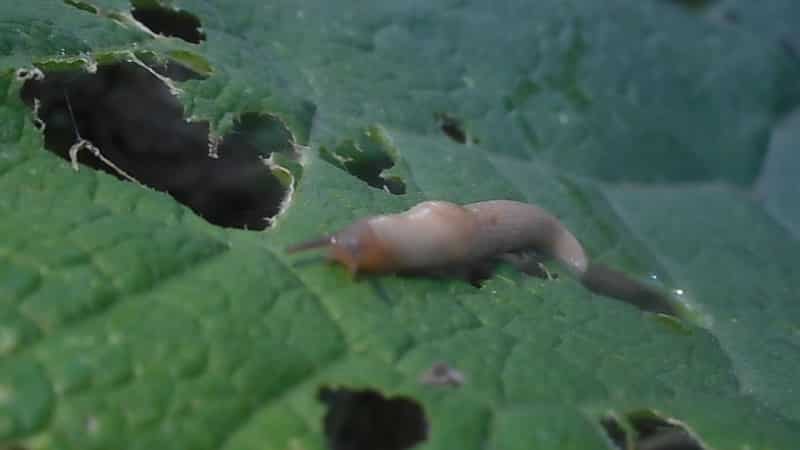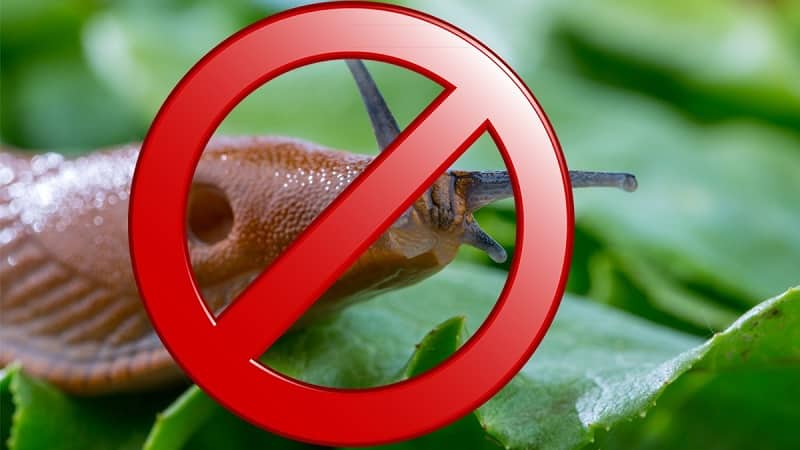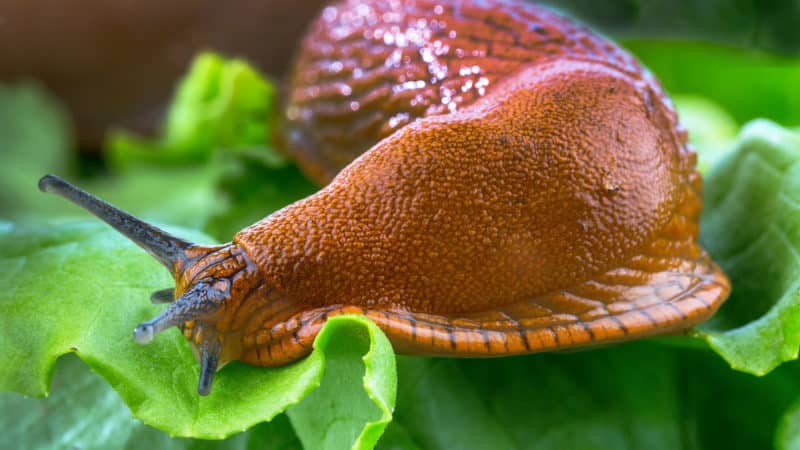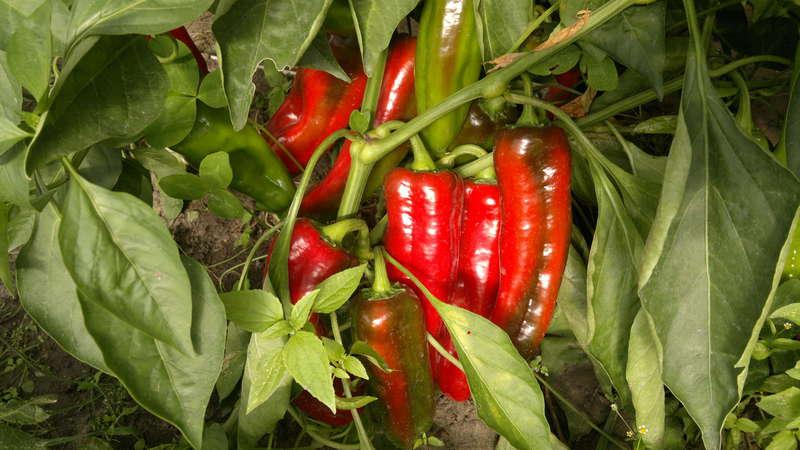Fast and effective pest control - slugs on peppers: how to detect and get rid of the problem
Every gardener puts not only his strength, but also his soul into growing crops. It’s all the more disappointing when all efforts go to waste because appearance of pests. Land mollusks or slugs can completely destroy a crop in just a few days.
What to do if slugs appear on peppers, how to rid an area of mollusks without harm to the crop using chemicals, folk remedies and agricultural techniques - you will learn all the most important things about pest control methods from our article.
Signs of pepper damage by slugs
Science distinguishes several types of slugs. Mollusks prefer to feed on garden crops with large, juicy tops. Summer residents complain that pests eat not only leaves, but also fruits.
The presence of a pest in an area can be determined by the appearance of small holes or cuts on the leaves of plants. Also, white mucus remains on the tops after the slugs move.
Slugs are nocturnal, so searching for them during the day makes no sense.

Damage caused
Mollusks gnaw large holes on the leaves of bell pepper, which disrupts plant photosynthesis, inhibits the development of the vegetable and negatively affects yield. In addition, slugs cause the development of powdery mildew, as well as other fungal diseases and rot.
Important! Pests can attack plants in open ground, in greenhouses and greenhouses.
In conditions of high humidity, the shellfish population increases rapidly. Slugs can destroy an entire crop in a matter of days.
Reasons for appearance
Mollusks prefer to settle in areas with abundantly moist soil. In such an environment there is usually a lot of vegetation, where it is convenient to hide from the sun's rays.
Slugs do not have a protective shell; their lifespan largely depends on their environment. Favorable conditions for them are high humidity and air temperature from +15°C to +19°C.
Most often, the pest enters open beds by moving from infected wild plants. When mulching plantings with freshly cut grass, be careful - there is a risk of introducing pests into the beds.
Factors that provoke the appearance of slugs in a greenhouse:
- air humidity more than 80%;
- irregular ventilation;
- excessive watering;
- dense plantings.
How to deal with slugs on bushes

How to treat the beds? Before deciding on pest control methods, assess the damage caused, as well as the number of shellfish. If there are few of them on the site, it is appropriate to remove slugs using agricultural techniques.
If, along with the appearance of pests, plants become infected with diseases, it is worth using folk remedies. Chemicals are used to kill large populations of slugs.
Slugs do not tolerate high temperatures, drought and direct sunlight.
Chemicals
Metaldehyde-based drugs are effective against slugs:
- "Storm";
- "Slug Eater";
- "Ferramol";
- "Meta".
The chemicals attract pests and then kill them. The drugs have a low level of toxicity, their use will not harm the environment and insects.However, the products are not recommended for use during the fruiting period.
“Superphosphate” is also used to get rid of slugs. The drug is applied to the bushes, as if powdering them. For 1 sq. m. 30-40 mg is enough.
Important! When working with insecticides, follow safety precautions: wear a protective mask, gloves and goggles.
Copper-based preparations are suitable for the destruction of land mollusks - copper sulfate and Bordeaux mixture.
Traditional methods
How to remove slugs from your property using safe and natural substances?
For years, gardeners have developed pest control strategies. We bring to your attention the most effective of them:
- White vinegar solution - 0.5 cups per 10 liters of water. Used to spray the plant and the soil underneath it. The time for the procedure is evening.
- Hot water. The mulch is watered with water at a temperature of +40°C. Pests are afraid of elevated temperatures; the result will be achieved even when using water at +30°C.
- Hot seasonings: pepper, dried garlic. The substances are scattered between the rows, having previously formed shafts 5 cm high.
- Coffee - 2 tsp. dissolve in 250 ml of water. The solution is used for spraying. You can use coffee grounds - the slurry is poured into the aisles.
- Corn flour. Plants are powdered with it.
- Tobacco dust. The product is used to treat plants and spaces between beds. A mixture of tobacco and ash is sprayed over the beds several times a day, then take a break for five days.
- Infusions of garlic or hot pepper. Grind 100 g of the ingredient and dilute it in 1 water. The concentrate is infused for a day, then diluted with 4 liters of water. The solution is used for spraying beds.
- Mulching with nettles or other dried aromatic herbs.
- Mustard powder — Add 150 g of the product to 10 liters of water and spray the pepper.
- Film. Plants are covered with film material at night. The slugs will gather under it and die during the day due to the increased temperature.
Often on gardening forums they give advice to treat the soil with salt. However, experts do not recommend using this method to get rid of pests, since salting the soil has a negative effect on plants.
Biological
How to get rid of slugs without using drugs? Their natural enemies - animals that eat shellfish - will help. These include hedgehogs, gray and green toads.
Agrotechnical techniques
The most effective way is to collect pests manually. Slugs are nocturnal, so special traps or baits are used to catch them. For example, kvass or beer is poured into a cut-off plastic bottle or any other container.
Beer can also be used in the evening to spray the beds or water the soil with it. Early in the morning all that remains is to collect the pests manually and destroy them.
After collecting slugs, the beds should be loosened to remove the larvae. Usually they are no deeper than 3 cm. To be completely sure of collecting all pests, it is enough to loosen the soil to a depth of 7 cm.
As soon as all the mollusks are removed, watering is stopped for one week, and the soil and plants are dusted with wood ash.
You can repel pests with the help of herbs. Mint, lemon balm, wormwood and tansy are planted along the perimeter of the plot, and parsley is planted between the rows. Garlic, rosemary, sage and thyme are also effective.
Sprinkling between the rows: crushed eggshells, pine needles, shells, nutshells or small pebbles will stop the spread of slugs.These materials damage the delicate body of pests.
Advice. Experienced gardeners dig small ditches between the rows, which are covered with quicklime and wood ash. These materials impede the movement of gastropods.
Features of fighting in greenhouses

The fight against slugs is combined with preventive treatment of plants against diseases. At the first signs of disease, the drug “Fundazol” is used. It is mixed with wood ash and sprinkled with peppers.
Manufacturers produce special products to combat slugs: flexible plastic tapes and copper rings. These methods are used during the fruiting period, when treatment with chemicals and folk remedies is undesirable.
In the open ground
More methods are available to eliminate pests in open areas. Some people prefer not to destroy slugs (since they are useful as natural orderlies), but to limit their movement.
Protects peppers from shellfish plant tops spread between rows, which are loved by slugs. In such places there will be an accumulation of pests, which will simplify their collection.
They are also constructing bait traps made from rags, pieces of plywood and boards. Slugs love such shelters. If you put them in the evening and water them with beer, in the morning a large number of gastropods will accumulate there.
Preventive measures
To prevent the appearance of slugs on the site, create conditions that are uncomfortable for them to live.

Prevention:
- regular inspection of plants;
- maintaining the cleanliness of the beds - promptly remove plant debris and other debris;
- the use of materials that impede the passage of slugs;
- installation of traps made of rags, cardboard and burdocks;
- maintaining intervals between plants;
- high arrangement of beds - the formation of small embankments;
- removal of standing water from the site;
- regular weed removal;
- digging up the garden at the beginning and end of the season to a depth of 20 cm;
- loosening the area after each precipitation and watering;
- pre-sowing treatment with copper sulfate;
- adding ash 1-2 times a season;
- moderate watering.
Read also:
Pests of tomatoes in a greenhouse and methods of controlling them.
How dangerous are black aphids on cucumbers and how to deal with the pest.
Conclusion
Slugs are common both in open areas and in greenhouse conditions. Some gardeners do not see anything wrong with them, since they can be useful. But when it comes to preserving the crop, chemicals, traditional methods and agricultural techniques come into play.
When eliminating gastropods, remember that their vital activity often leads to the development of diseases, so pest control should be combined with preventive treatment of the beds.